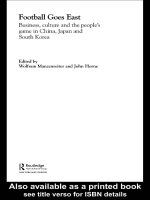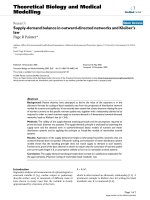SPECIALIZED REPORTS topic demand response in japan, south korea and singapore
Bạn đang xem bản rút gọn của tài liệu. Xem và tải ngay bản đầy đủ của tài liệu tại đây (3.61 MB, 90 trang )
HANOI UNIVERSITY OF SCIENCE AND TECHNOLOGY
SCHOOL OF ELECTRICAL ENGINEERING
********************
SPECIALIZED REPORTS
Topic: Demand response in Japan, South Korea and Singapore
Instructor: Assoc. Prof Nguyen Duc Tuyen
Students:
Pham The Thien
Khong Truong Thinh
Ly Duc Trung
Vu Cong Tuan
Pham Xuan Tung
Phung Dang Tung
Nguyen Hoang Viet
Phan Trong Vinh
Hoang Ngoc Vu
Ha Noi, 7 - 2020
1
20181925
20181927
20181930
20181932
20181933
20181934
20181935
20181936
20181937
TABLE OF CONTENTS
TABLE OF CONTENTS...............................................................................................................................2
INTRODUCTION.......................................................................................................................................4
1) Overview of the topic:.....................................................................................................................4
2) Difficulties in this project:................................................................................................................4
3) Scope of the study:..........................................................................................................................4
4) Research Methodology:..................................................................................................................5
5) Structrue of the report:...................................................................................................................5
CHAPTER 1: DEMAND RESPONSE DEFINITION AND THINGS RELATED TO DEMAND RESPONSE..............6
1.1) Definition of demand response:...................................................................................................6
1.2) Types of Demand Response:........................................................................................................6
1.3) The reason that a company want to participate in demand response:........................................8
1.4) The reason that a utility wants customers to participate in DR programs:...................................9
1.5) How demand response is different from energy efficiency:.........................................................9
1.6) Providers of demand response:..................................................................................................10
1.7) How renewables and demand response tie together.................................................................11
1.8) Reality check: What could make demand response work effeciently?.......................................11
CHAPTER 2: DEMAND RESPONSE IN JAPAN...........................................................................................12
2.1) History of DR in Japan:...............................................................................................................12
2.2) How DR affects people in Japan.................................................................................................21
2.2.1) Outcome of Demand Response:..........................................................................................21
2.2.2) Details of Demand response:..............................................................................................24
2.3) Challenges and development orientation of demand response in Japan...................................26
2.3.1) Challenges:..........................................................................................................................26
2.3.2) Development orientation:...................................................................................................27
CHAPTER 3: DEMAND RESPONSE IN SOUTH KOREA..............................................................................30
3.1) Introduction:..............................................................................................................................30
3.2) Materials and Methods:.............................................................................................................34
3.2.1) Status of Demand Resources Market, South Korea:............................................................34
3.2.2) Development of Demand-Side Management Solution (DSMS):..........................................39
4.3) Demand response market programs:.........................................................................................45
2
4.3.1) Definition:............................................................................................................................45
4.3.2) Processes:............................................................................................................................46
4.3.3) Qualification:.......................................................................................................................46
4.3.4) Bidding and Market Clearing:..............................................................................................47
4.3.5) Evaluation:...........................................................................................................................47
4.3.6) Settlement:..........................................................................................................................48
4.3.7) Examples:............................................................................................................................48
4.4) Results:.......................................................................................................................................49
4.5) Implication:................................................................................................................................56
4.6) Conclusion for demand response in South Korean:....................................................................57
CHAPTER 4: DEMAND RESPONSE IN SINGAPORE..................................................................................59
4.1) History, abstract:........................................................................................................................59
4.2) Background:...............................................................................................................................61
4.3) Benefit of DR participants in Singapore:.....................................................................................62
4.3.1) Double-side biddinng and market clearing:.........................................................................62
4.3.2) Multi-agent simulation:.......................................................................................................63
4.3.3) The way of bidding:.............................................................................................................66
4.4) The features of the Demand Response programme:..................................................................68
4.4.1) Eligibility:.............................................................................................................................70
4.4.2) Demand side bidding:..........................................................................................................71
4.4.3) Incentive payments to DR providers:...................................................................................72
APPENDIX..............................................................................................................................................76
1) Some images of Tokyo Power Electric Company (TEPCO):............................................................76
2) Leading companies in utilizing demand response:........................................................................78
OVERVIEW.............................................................................................................................................79
1) Advantages of demand response:.................................................................................................79
2) Challenges of demand response:..................................................................................................80
3) Future of demand response:.........................................................................................................80
4) Similarities and diffenences of demand response in Japan, South Korea and Singapore:.............81
REFERENCES..........................................................................................................................................86
3
INTRODUCTION
1) Overview of the topic:
Nowadays, natural resources management, especially grid stabilizing, has
become a growing concern for countries around the world. One of the most reliable and
cutting-edge solution for the issue is Demand Response (DR), which act as a way to
not only protect the grid system, but also to provide two-way benefits between
customers and electricity retailer. The technology, even though has been researched and
put into use for a long time, is still a hot topic with much potential to be developed.
This book aims to give readers the most intuitive view of a multi-billion dollars
initiative.
2) Difficulties in this project:
Although there are a variety of references related to the topic, most of the
reliable sources have the excess fee larger than our team’s funding. Besides, since this
is our first time forming an academical report, errors such as informal language, or
incorrect statistics used are hard to prevent.
3) Scope of the study:
In this study, we look into the development of DR programs of Singapore, South
Korea, and Japan in order to have a more profound view into the chain of events which
lead to the development of DR programs in each country, as well as to facilitate the
comparison between each nation’s DR model.
4
4) Research Methodology:
We use the method of listing, comparing and analyzing each stage of
development of DR model in the three mentioned to clearly visualize DR programs
advancement.
5) Structrue of the report:
– Table of contents
– Introduction
– Chapter 1: Demand response definition and things related to demand response
– Chapter 2: Demand response in Japan
– Chapter 3: Demand response in South Korea
– Chapter 4: Demand response in Singapore
– Overview
– Appendix
– References
5
CHAPTER 1: DEMAND RESPONSE DEFINITION AND
THINGS RELATED TO DEMAND RESPONSE
1.1) Definition of demand response:
Demand Response (DR) is broadly defined as “changes in electric use by enduse customers from their normal consumption patterns in response to changes in the
price of electricity, or to incentive payments designed to induce lower electricity use at
times of high wholesale market prices or when system reliability is jeopardized.
Consumers first may become aware of demand response programs during heat
waves, when there are worries about adequate power supply. For example, last summer
the New York City grid "shed load" by reducing power at a number of public services,
including the Metropolitan Transportation Authority, and utility ConEdison activated a
voluntary program to adjust consumers' air-conditioner thermostats at peak hours. In
exchange for participating in these voluntary programs, electricity customers receive a
rebate. Without demand response, the grid operators would rely on expensive and
polluting auxiliary power plants or, if that didn't provide enough power, being forced to
stop supplying certain areas.
Demand response also has been a key reliability tool in the winter. The frigid
weather last winter caused grid reliability concerns because some generators failed. In
Texas and other places, grid operators called on demand response resources to avoid
brownouts or blackouts.
1.2) Types of Demand Response:
– Dispatchable Incentive-based DR Programs:
6
+ Curtailable Load Program - CLP (voluntary program targeted at the industrial
and commercial customers that have flexible production lines with consumption
ranging from low levels to high levels). The CLP is an economic based program and is
designed to drive efficiency and reduce the cost of production for the marginal unit of
electricity. Before 24 hours of the peak hour, utilities will send notifications to
customers to request to know whether customsers are able to cut down power usage on
the next day. If they could diminish power usage, they will be received an amount of
incentive money.
+ Emergency Demand Response Program - EDRP (voluntary program targeted
at the industrial and commercial customers that have flexible production lines with a
wide rage of consumption levels and are able to change or reduce electricity demand
quickly). The EDRP is designed to ensure power system reliability. Demand response
is deployed in the event that the power system is overloaded. The main customers of
this program are those who can voluntarily cut down power usage quickly and flexibly,
usually within 2 hours after receiving the notification. The rewards for these customers
are often of high value.
– Non-dispatchable Time-based DR Programs:
+ A two-tiered electricity price program (demand charge and energy charge; targeted at
customers who have already been on Time of Use tariff). There is no direct financial
incentive mechanism for this program. Customers need to actively decide to adjust or
change their demand to respond to price signals, especially within the peak time period
to reduce electricity billing. For example, if customers participating in the two-tiered
electricity price program use electricity during peak hours will be charged twice as
much as other time frames.
+ Real-time peak-load electricity tariff program or PLT-DR (voluntary program
targeted at industrial and commercial customers). The price includes TOU tariff and
7
special tariff for the peak time periods (The peak time periods are announced on a caseby-case/time-to-time by authorized operators.).
– Non-commercial DR Programs:
+ In this model, there is no financial incentive. The reward can be a “payment” in the
form of preferential treatment if curtailment load is implemented as a last resort
measure to maintain integrity of the power system.
– Voluntary DR Programs:
+ In this model, there is no financial incentive. The reward may be in the form of
goodwill as the customer is seen as contributing to social good. It is unclear whether
and how a corporation can incorporate such goodwill in its accounting system. This
case rarely happens because cutting down power and receiving no rewards will greatly
affect production activities and revenue of customers.
1.3) The reason that a company want to participate in demand response:
Commercial or institutional customers can save money and help the grid stay
stable. Reducing power at peak times can be more or less transparent to the end user,
proponents say. For example, changing thermostat settings on a supermarket freezer or
dimming the lights in a hotel lobby for 15 minutes can be done in a way that doesn't
affect people.
How much an individual or company can earn by participating varies by utility
and region. But PJM, considered the most progressive in implementing demand
response and related services, pays significant sums out to companies that do voluntary
reductions. In one month in 2012, PJM paid out $5 million to demand response
8
providers. Equipment provider Schneider Electric says demand response programs can
earn back 5 percent to 25 percent of their annual electricity costs.
1.4) The reason that a utility wants customers to participate in DR programs:
In many states, regulators create incentives for utilities to use less energy,
particularly at peak hours of the day. Initially, demand response programs were put in
place to avoid having to turn on "peaker plants," or auxiliary power plants that may be
pressed into service only 10 days a year to meet high demand. So instead of building
new power plants to meet demand, utilities instead can rely on power curtailments. In
New York, for instance, 543 megawatts of curtailments are available just from
commercial and industrial customers, which is about the same capacity as a medium
size power plant.
Keeping these plants idle also helps keep the price of power down. Instead of
having to call on very expensive power generators to meet high demand in the late
afternoon, grid operators can reduce the load and avoid paying peak-time pricing. In
one week in 2012, PJM estimates its region saved more than $650 million in one
week from voluntary curtailments.
1.5) How demand response is different from energy efficiency:
– Responding means rewards:
The key to demand response is in its name. Put simply, it means responding to
demand in the market, to balance the supply and demand equation.
It can be as straightforward as temporarily reducing your power during periods
of high pricing, either partially or fully. This could mean switching over to a backup
generator or turning off non-essential operations.
9
– Energy effeciency:
Unlike demand response, the goal of energy efficiency is to reduce how much
energy your business uses. It’s an ongoing approach that requires more efficient use of
power.
While demand response generally does not require investment, energy efficient
processes may have an upfront cost. This expense could come in the form of paying to
better insulate your premises or upgrading to more energy efficient machinery.
1.6) Providers of demand response:
Utilities can run their own demand response programs or rely on third-party
companies. EnerNoc and Comverge, for example, install the control equipment at
customer sites and manage the curtailments based on price signals from the grid
operators. EnerNoc manages tens of thousands of commercial sites from a network
operations center where employees monitor energy demand and bid their services into
wholesale energy markets.
Having two-way communications is a big step forward, says Kellison (Ben
Kellison, an analyst at GTM Research). Before, utilities didn’t know for sure how
much power actually was shed during peak hours, whereas now they can verify
reductions and better control how they use demand response. For example, a utility
may know that one feeder on the distribution grid overloads 10 days a year and and can
target that area for demand response participation.
10
1.7) How renewables and demand response tie together
Demand response can be a way to smooth out some of the fluctuations from
variable wind and solar. Smooth out some of the fluctuations means to keep the
demand of energy to be not too different from the amount of power supplied. Devices
such as water heaters or potentially electric vehicles can be adjusted quickly, which
means they can compensate for a dip or surge in wind power, says Kellison (Ben
Kellison, an analyst at GTM Research). That's one reason why demand response is
becoming a bigger topic in Europe, he says.
In a survey conducted by the Peak Load Management Alliance, 38 percent of
industry professionals said that demand response was the best way to handle the
variable nature of solar and wind. The top response was energy storage with 43
percent.
1.8) Reality check: What could make demand response work effeciently?
An ongoing challenge for demand response is signing on participants. If the load
adjustment is poor, for example, the remote-control station controls the air conditioner
of the customer and makes it inconvenient, the customer will abandon the idea of
participating in the adjustment of the electric load. Although programs are voluntary,
some people bristle at the very idea of a utility controlling their energy consumption.
Letting people adjust their thermostats manually could allay those concerns with some
people. Commercial customers, too, don't want to make sacrifices even if they save
money on their bills, so curtailments ideally should be done in a way that doesn't cause
disruptions.
At a high level, demand-side management represents a fundamentally new way
of running the grid. Instead of simply turning up the power to keep things steady,
11
operators actively can manage both the supply and demand ends to maintain balance
and save energy at the same time.
CHAPTER 2: DEMAND RESPONSE IN JAPAN
2.1) History of DR in Japan:
– In 11/3/2011:
+ Great East Japan Earthquake, subsequent Tsunami
Fig 1. Great East Japan Earthquake
Fig 2. Subsequent tsunami
+ Fukushima Nuclear-Accident made Rolling Blackout in TEPCO Area, Nation-wide
campaign for saving kWh.
In March 2011, the Great East Japan Earthquake and subsequent tsunami
seriously damaged the Fukushima Daiichi Nuclear Power Station. Prior to these
disasters in 2010, 29% of Japan’s electricity was supplied by nuclear energy, while the
shares provided by fossil fuels and renewable energy sources were, respectively, 62%
12
(liquefied natural gas (LNG), 29%; coal, 25%; oil, 8%) and 10% (hydropower, 9%;
other renewables, 1%).
Fig 3. Fukushima Nuclear-Accident
Fig 4. View after the earthquake
– In 6/2012: DR Initiative (METI):
“Smart House & Building Standardization and Business Study Committee”
+ DR Use cases
+ Communication Standards:
ECHONET Lite (HAN)
Open-ADR (TSO-Aggregator)
13
Fig 5. ECHONET Lite
Fig 6. Open-ADR (TSO-Aggregator)
In 2013, when nuclear generation accounted for only 1% of total power supply
and the share obtained from fossil fuel sources had increased significantly to 88%
(LNG, 43%; coal, 30%; oil, 15%), while that from renewables remained at 11%
(hydropower, 9%; other renewables, 2%).
The dramatic fall in nuclear power generation was due to a suspension of
operations after the disasters. The nuclear power plants that were not directly damaged
14
by the earthquake were gradually shut down for scheduled maintenance. In the end of
September in 2013, the last two nuclear reactors were shut down; thus, all of Japan’s 48
reactors were suspended until given approval to restart from the Nuclear Regulation
Authority (NRA)
In 2015, Almost half of those reactors were undergoing NRA safety assessments
as of early this year, but their restarted operation will not be fully approved for a long
time because of an envisaged six months (or much longer) timeline for rigorously
assessing each case. In addition, local governments’ agreement and local communities’
acceptance are necessary for the nuclear reactors to resume operations.
In January 2016, (METI) “Energy Resource Aggregation Business Study
Committee” was held:
– METI’s Official Announcement
– Third Meeting of “Smart House & Building Standardization and Business Study
Committee” (May 15, 2013)
+ DR Technology and Standard - Summarize use cases of demand response
(DR) and prepare a standard method for automated DR between power utilities and
aggregators based on Open-ADR + Specification and Policy - Summarize “Specification for DR interface,
Ver1.0” which covers Open-ADR 2.0a and a part of 2.0b. - In this framework, vendors
are supposed to develop their soft or hard wares in compliance with the conformance
rule determined by Open-ADR Alliance (Spec. 2.0a and/or 2.0b).
In 29th February 2016, the four smart community projects funded by the
Japanese government, in collaboration with the private sector, included various
residential demand response schemes. These demonstration experiments conducted
from FY2011 to FY2015 have shown peak reduction levels of 10% to 20%by relying
on a combination of technologies egg, Home Energy Management Systems (HEMS) as
15
well as time-of-use (TOU) or critical-peak pricing (CPP) for residential electricity
users. Based on these preliminary results, researchers led by Kyoto University’s
Professor Ida, have conducted cost-benefit simulations to evaluate the impact of
expansion of residential demand response (DR) across all of Japan (excluding
Okinawa). The goal of the study was to evaluate the cost and benefits of residential
demand response based on universal adoption of HEMS, as proposed by Japan’s
Cabinet Secretariat in 2012.
Fig 7. Peak demand reduction by each DR retail menu (left axis: MW, right axis: %)
Rules for transactions between businesses and communication standards for
remotely controlling energy devices were enacted within fiscal 2016.
All of these things push the formation and development of DR quickly in Japan.
The Ministry of Economy, Trade and Industry ( 経 済 産 業 省 , Keizai-sangyōshō) or METI, is a ministry of the Government of Japan. It was created by the 2001
Central Government Reform when the Ministry of
16
International Trade and
Industry (MITI) merged with agencies from other ministries related to economic
activities, such as the Economic Planning Agency.
METI has jurisdiction over a broad policy area, containing Japan's
industrial/trade policies, energy security, control of arms exports, "Cool Japan", etc.
METI is known for its liberal atmosphere and officials of METI have been well known
for their excellence. It is commonly called "human resource agency" for its leaders of
politics, business and academia.
In 2017, METI opened the “Negawatt” market. The first auction for demand
response (DR) was reported to net about 1GW of capacity from industrial and
commercial power consumers. Demand Side Management (DSM) where households’
demand reduction potentials are aggregated have been part of pilot projects but not yet
commercialised. It is generally considered that the DR potential is huge in Japan.
Under the current rules, participation in DR market is voluntary, but when the
Government responded in 2011 to the shutdown of the nuclear reactors in the TEPCO
service zone by imposing an obligatory peakload reduction on the industry, the peakload was reduced by 15% (Takahashi 2013). Sasakawa Peace Foundation (2018)
quotes another source which estimates that DR could reduce the national peak load by
about 9%. The Government’s target is a 6% reduction in peak demand in 2030.
– Eliminates need for 10 million kilowatts in power generation capacity, or 10 nuclear
reactors
– Allows power companies to slash up to 90 billion yen per year in facility renovation,
construction, and operations costs.
– Negawatt aggregators play core role serving as mediator between consumers who
control electricity demand and electricity utilities, and in tallying electricity savings
from consumers
17
– METI has drawn up guidelines for negawatt trading, including power-saving
calculation.
– Japan selects Enernoc to expand demand response market:
Global energy intelligence software firm Enernoc partnered with the Japan
Institute of Applied Energy (IAE) for the rollout of a demand response programme.
The partnership aims to demonstrate how transmission, distribution and system
operators in the East Asian island nation can make use of demand response measures to
ensure grid reliability. In a press statement, Enernoc said it will use its collaboration
with IAE to help power companies balance power demand and available power to
avoid blackouts. David Brewster, president of Enernoc, commented: “This new project
is another step forward in the unprecedented electricity market reform occurring in
Japan, and it will help cement the importance of demand-side management not only in
Japan, but across the globe as well.” The deal adds to previous collaborations between
Enernoc and the Japanese government departments in deploying demand response
initiatives.
Fig 8. Logo of Enel X company
Enel X is a company of the Enel Group that provides products and services
aimed at energy transformation at home, city and industrial level, with a view to
sustainable development. By applying solutions resulting from the digital
transformation to the energy sector, Enel X is dedicated to the fields of electric
mobility, smart homes and smart cities, intelligent public lighting, integration of
renewables, energy efficiency for businesses and public administrations. Its main office
is in Rome. The firm has participated in the Japanese demand response market since
18
2013. The solutions provider is hoping to use the contract to provide the largest
demand response capacity to the government of Japan.
Fig 9. Enel X protocol
Fig 10. The headquarters of Enel X in Rome
– State funded demand response initiatives:
19
In recent years, renewable energy and demand-side resources have been key
issues as Japan (and the US, EU, and many other countries) attempts to tackle the
dilemma of securing its energy supply without further increasing its environmental
footprint; these challenges have become particularly acute after the energy crisis. The
Japanese government seeks to double the share of renewable energy in national
consumption to reach 24% in 2030 while increasing nuclear power to about 20%, still
below the pre-Fukushima level. 5 Although there is little scope for increasing
hydroelectric power (9%) in Japan, the government envisages the share of solar
photovoltaic (PV) power rising to 7% in 2030, followed by 5% from biomass, 2% from
wind power, and 1% from geothermal power. 6 Specifically, PV power generation
capacity is expected to increase from 13GW in 2013 to 64GW in 2030, a fivefold
increase.
Considering demand-side management, the Japanese government expects 17%
energy savings compared to the reference case. One key target is to improve efficiency
in residential energy management. Most Japanese residential consumers are currently
charged flat-rate tariffs for electricity using conventional analog electric meters, but the
government plans to install digital smart meters in all households (about 50 million) in
Japan by 2024. Along with smart meters and possibly home energy management
system (HEMS), dynamic pricing schemes, such as critical peak pricing (CPP) and real
time pricing (RTP), are expected to induce residential consumers to use electricity
more efficiently.
20
Fig 11. Real time pricing
2.2) How DR affects people in Japan
2.2.1) Outcome of Demand Response:
First, let’s take a look at Table 1, which shows the peak cut in the TEPCO
service area. Peak demand in post-disaster 2011 dropped 18% from the pre-disaster
21
peak demand in 2010. Consequently, the TEPCO service area was able to avoid
massive blackouts.
This was not just a one-off phenomenon on the day of peak demand. Chart 1
tracks peak demand for every summer day (July 2 through Sept. 2) in the TEPCO
service area. Average peak demand dropped from 51.32 gigawatts (GW) in 2010 to
40.89 GW in 2011. In other words, consumers in the Kanto region collectively
achieved an average reduction of 20.3%. The average high temperature was 1.6 C
lower in 2011 than in 2010, when it was exceptionally hot. But even after taking that
into consideration, it is safe to say that a roughly 15% reduction in peak demand had
been achieved.
Table 2 shows that the 2011 summertime peak demand in the Kansai region
dropped 10.1% from 2010. This is only a little more than half of the reduction in the
TEPCO service area, although it is still a significant amount. However, the reduction
from the 2010 peak widened to 13.4% in 2012 — more than a year after the disaster —
even though the high temperature was 1.1 C above the previous year. The reason for
this was that the supply shortage in the Kansai region widened in 2012 and electricity
consumers responded.
The Kansai region also shows this trend not only on the day of peak demand but
throughout the summer. Chart 2 shows that the average summer peak demand (July 2
through Sept. 2) in postdisaster 2011 dropped 9.2% from 2010. This margin widened to
11.8% in 2012. Although the Kansai region was not directly affected by the disaster,
electricity consumers will come forward with demand response if they correctly
understand the electricity shortage situation.
2.2.2) Details of Demand response:
How did the Japanese people execute demand response? Many offices and other
facilities took measures such as raising the setting on air-conditioners to 28 C, reducing
the number of lighting fixtures in use, switching to energy efficient LED light bulbs,
switching office computers to battery mode during peak demand afternoon hours, and
reducing the number of elevators and escalators in use or turning them off entirely,
according to an interview survey of businesses conducted by the Ministry of Economy,
Trade and Industry and made public in the autumn of 2011. Efforts were also made to
level the load by altering work patterns, such as encouraging “Cool Biz” light summer
wear more thoroughly, staggering lunch breaks, and staggering days-off for summer
vacations, which typically concentrate around the middle of August.
Demand response also reached the factory floor. Measures to reduce electricity
consumption at the summer peak were taken, such as shifting factory operations to
nighttime, alternating operation hours between businesses (in effect reducing operation
hours), increasing production through June and meeting subsequent summertime
demand with stock, increasing production in western Japan, where there were no
electricity shortages, and even increasing overseas production. Automobile
manufacturers drew a lot of attention when they executed drastic peak shifts by
switching weekday production to the weekend.
24
Large factories made an immediate impact by operating private power
generators full-time and installing new ones. Factories that require 24-hour continuous
operation secured their own stable electricity supplies. When restrictions under the
Electricity Business Act on sharing electricity within corporate groups were eased,
some businesses used this to their advantage. The demand side cooperated in
mitigating the peak load not only by reducing demand but also by increasing their own
supply.
One reason why businesses worked on demand response was that they were
eager to cooperate to stabilize electricity supply in light of the post-earthquake crisis
looming over Japan. However, even more important was the fact that the government
issued an order to restrict the use of electricity under Article 27 of the Electricity
Business Act. This order imposed an across-the-board 15% reduction of peak demand
on large-scale consumers with contract power of 500 kilowatts or more, backed with
the strong enforcement power of fines on violators.
Households were not under any such obligations but cooperated willingly
anyway when the government issued electricity conservation targets. Grassroots
measures were taken everywhere such as reducing the use of air-conditioners and
switching to electric fans, opening and shutting refrigerator doors as infrequently as
possible, putting TV sets in power saving mode, using rice cookers early in the
morning to meet the needs for the entire day, and switching off the main power
supplies for TV sets and other household electric appliances. The government and mass
media cooperated in publicly sharing such knowhow.
2.3) Challenges and development orientation of demand response in Japan
2.3.1) Challenges:
25









